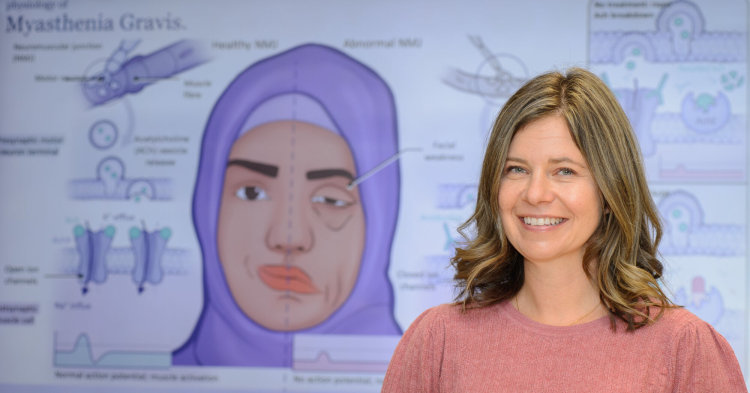A new database of open-source physiology illustrations is now available that reflects the diverse population of students in Canadian universities, thanks to the work of a Western professor and graduate.
Traditional teaching images from textbooks and other sources can be expensive and do not allow instructors to modify the images for their lessons, so physiology and pharmacology professor Anita Woods and Western alum Priya Modi decided to try to find a solution.

Schulich Medicine & Dentistry professor Anita Woods wanted more diverse images used to teach physiology. She works with artists, including students in her classes who want to design new illustrations, to make it happen. (Christopher Kindratsky/Western Communications)
"These images are royalty-free and downloadable," said Woods. "Everything will come as a PowerPoint slide set with multiple layers, so an instructor can choose what they show to match their lesson and what level they're teaching at - it just includes attribution to the artist."
Aside from making the images easy to adjust, the team also incorporated diversity into the illustrations, making them more representative of who's in the classroom and helping students feel welcome and accepted.
Modi, BMSc'23, led the work, developing it as an open educational resource (OER), Physiology Diversified.
"The goal is to make the visuals more diverse, equitable and inclusive in a way that speaks to a broad majority of people and resonates with a student audience. I also wanted to ensure the website itself is easy to use, user friendly and accessible," said Modi, who created both the images and the online platform that would make them easily accessible as part of her master's in biomedical communications at the University of Toronto.
The illustrations can help students better understand the factors contributing to human physiology and disease, showing diverse individuals who are both healthy and sick.
"Race and diversity can affect the outcome of what you're teaching. For example, skin rash presentations of adverse drug reactions can be very different based on the tone of the skin," Woods said.
To create the images, Modi looked first at the demographic affected by a specific disease, then at who was underrepresented in existing materials to incorporate diversity in areas like gender, age, size and ability.
"When you go into the real world and see so much patient diversity, you don't necessarily see what's depicted in the commercial textbooks. It also benefits the student sitting in the classroom to know and understand there's a lot of diversity that exists," Modi said.
New images have broad classroom applications
Woods hopes the images will be used by other post-secondary institutions and also secondary school educators, which would give students consistent imagery, potentially making learning easier. There is also potential for use in patient education and other areas of science communication.
Oana Birceanu, professor of physiology and pharmacology at Western, said she values having access to images that are consistent and can be layered to model different conditions, so complexity can be increased over time.
"Imagine how powerful it would be if a student in Grade 12 is learning using this image, and then they're moving to university and they're seeing it again. Now we're building onto the complexity from high school, to what they're actually learning in human physiology classes at Western or at another institution using the images."
Birceanu believes the potential list of users for this kind of database of images goes beyond human physiology.
"It's human-first, but I think it can have multiple applications across a variety of fields, particularly if you're talking about a cell or organ system," she said.
Woods and additional students she's engaged in the project plan to continue collaborating with artists, expanding the website to host a larger number of images. There is already an option on the site for users to request other images.
This work is supported by grants from Western's BrainsCAN initiative and the Centre for Teaching and Learning.










